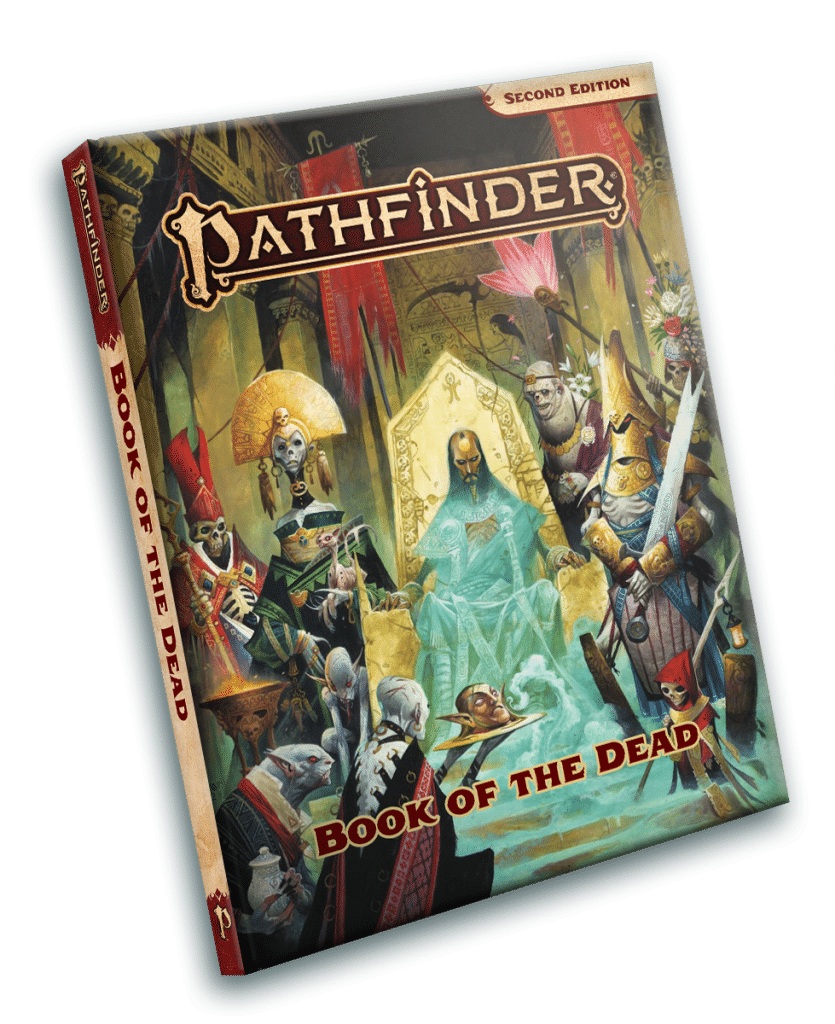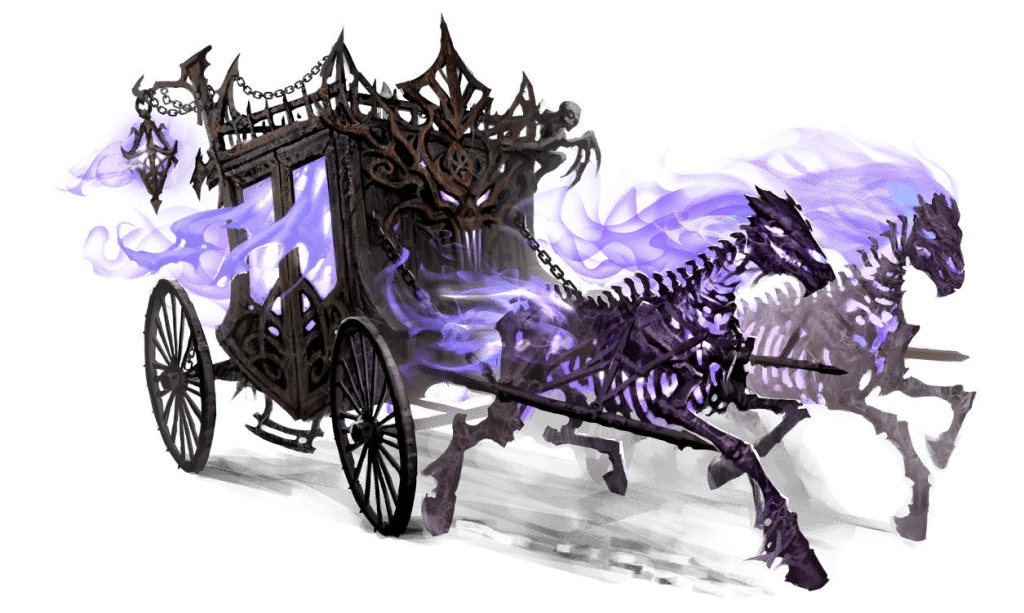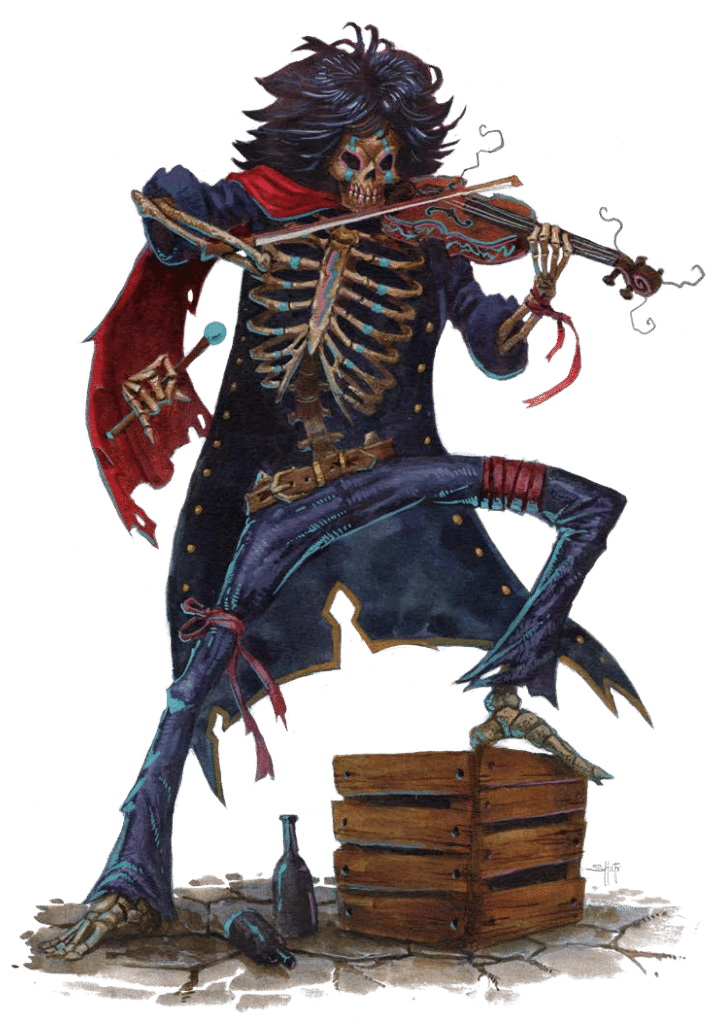Book of the Dead, the latest sourcebook for Pathfinder Second Edition (PF2), is Paizo bringing out the dead. This book is full of inspiration, character options, and undead monsters that are sure to bring the unlife to your tables!
I remember when I first started playing fantasy tabletop roleplaying games and one of the first things I wanted to do was command a horde of skeletons. And now, with the Book of the Dead, I’m at least able to command a couple of them in Pathfinder Second Edition.
This also might be the most comprehensive book for Pathfinder Second Edition thus far. Between the archetypes, Lost Omens flavor, Bestiary entries, and an undead adventure packed within, it covers the spread in terms of content. I’m trying to think if any other non-AP Paizo books have an adventure included, and I can’t think of any off the top of my head.
In any case, let’s get into the details of the book!
![]() Book of the Dead: Who It’s For
Book of the Dead: Who It’s For
If you’ve already read the Secrets of Magic book, you’re going to be familiar with some of the stylistic choices in Book of the Dead. There are sections of the book that are written by Geb, with excerpts from his text The Mysteries of Unlife. Nobody likes talking about death, so ‘unlife’ is a bit more accepting.
Within the book, we get introduced to some new Backgrounds, Archetypes, Items, Haunts, a substantial Bestiary, lore, and an adventure. In that sense, the Book of the Dead is really a product that will have great appeal to players and Gamemasters alike. Players who want to roll up a Mummy or Lich character will be able to dip their skeletal toes into the waters of those archetypes. Likewise, Gamemasters will have plenty of juicy undead fodder to comb through, including tips on how to write ghost stories or develop backstories for the undead.
I’d argue that Gamemasters get the better end of the deal with about two-thirds of the book dedicated to them. But players getting about 70 pages isn’t anything to shake a stick at either. Both groups will find a lot to love in the Book of the Dead‘s pages.
I did find some of the archetypes to be more exciting than others, at least in terms of the undead player options. For example, it’s not really all that feasible to create a Vampire character until you can pick up the Daywalker feat. Which means that you would need to either start at a higher level or work with the GM to incorporate the transformation into your campaign.
On the other hand, I really want to roll up a Mummy character. There’s a particular Feat, Storm Shroud, that reminds me so much of the Brendan Fraser Mummy movies since it allows you to create a swirling storm of rain, sand, snow, or clouds. Remember when the big storm Mummy swallows the plane?!
Don’t forget that the Book of the Dead also includes non-undead archetypes as well. For example, you could now easily make yourself a Van Helsing-style Undead Slayer or a Charon-adjacent emissary that shepherds souls with the Soul Warden archetype.
Everything in the book is teeming with flavor. It features some of the most evocative class choices for Pathfinder Second Edition to date, while still giving you plenty of freedom to shape them into a unique character or story moment for your table.
If you love things that go bump in the night, the Book of the Dead might be the supplement that you’ve been waiting for. Just to summarize the various archetypes to help you understand the contents better:
- Exorcist – Quell restless spirits
- Hallowed Necromancer – Bolster the living
- Soul Warden – Uphold the cycle of souls
- Undead Slayer – Hunter of unlife
- Reanimator – Command undead
- Ghost – Keep ties to the living world
- Ghoul – Victim of the Fever
- Lich – Separate soul from body
- Mummy – Undergone funeral rites
- Skeleton – Them bones
- Vampire – Feast on blood
- Zombie – Animated corpse
No matter how you slice it, there’s plenty to choose from that can satiate any player! Gamemasters – don’t forget that you can apply these same archetypes to your own creatures and NPCs as well.
It is interesting to include an adventure in a sourcebook like this. You’ll need the honor system to ensure that players who picked up the book to play a Zombie aren’t going to spoil the adventure for themselves in the process. Don’t get me wrong; I love the choice! Paizo is giving us a sandbox to test out our new toys and THAT is quite exciting.
![]() Book of the Dead: The Best Parts
Book of the Dead: The Best Parts
Now let’s take a look at my top three takeaways from the Book of the Dead. These are things that caught my eye when reading through the book, and the things I’m most excited to bring to the table.
Mummy (Pg 53)
I really put the cart before the horse on this one. I’m just really excited to play a Mummy! Just like some of the other undead archetypes, the mummy doesn’t really come online right away. I would say that picking up Accursed Touch (Feat 8) is the turning point for the archtype, as it grants a critical specialization effect that imbues the enemy with persistent negative damage and stupefied 1. However, this goes a step further if you pick up Channel Rot (Feat 10) which makes that Accursed Touch apply to any melee weapon instead of just your Strikes! That’s huge.
Those who have followed my articles for awhile also know that I love theme and incorporating lore into mechanics. The One With the Land (Feat 4) feat takes mummies to whatever terrain you really want, instead of being restricted to the usual sandy deserts. With other feats like Ensnaring Wrappings and Desiccating Inhalation, this is quite the flavorful archetype.
Fiddling Bones (Pg 92)
We all know what happened when the devil went down to Georgia. The Fiddling Bones creature is a poor soul obsessed with music that died before they achieved their true potential. Thanks to their Dance with Death ability, a fiddling bones can compel others to dance a jig due to their catchy tunes. And, if that song keeps going, they can perform a Destructive Finale to turn that crescendo into a damaging blast of sonic damage. I feel like most Bards who take the Skeleton archetype are just going to turn into fiddling bones regardless of what I throw at them from the GM chair.
This creature isn’t exceptionally powerful or outlandish, but it’s just one of those instances that showcases fun at the table. It’s like someone asked, ‘what if we took a skeleton, made them exceptional at music, and all they wanted was a willing audience?’ So tragic!
The reason why this makes my top 3 list for the Book of the Dead is that the fiddling bones shows off undead in a different light than we might be accustomed to. And that’s a thoughtline that we get throughout the entire book. Sure, you have your average run-of-the-mill ghouls, ghosts, and ghasts, but at the same time you have creatures like the Pale Sovereign (136) and Zombie Mammoths (173). Paizo continues to expand our creativity by showing off their own.
March of the Dead (Pg 190)
I’m not going to spoil the March of the Dead adventure that’s included with the Book of the Dead. It’s going to be much more enjoyable for you to play through it. But, I did want to point out that I think this is a bold and worthwhile addition to the Pathfinder Second Edition books assuming that Paizo uses this as an opportunity to start a trend.
There have been countless times throughout the years where I see something really neat in a sourcebook and then I wrack my brain trying to figure out how I’m going to work it into my existing campaign. Even something as ‘commonplace’ in fantasy tabletop role-playing games as undead isn’t necessarily applicable to every campaign that you’ll be running.
By incorporating an adventure into the sourcebook, Paizo is taking away all of the ambiguity by saying ‘try out this book HERE.’ And I love that. It’s great to having another plug-and-play module for 3rd level characters that works as a standalone adventure or as a part of a larger story.
Obviously the adventure features undead, but I appreciate the content advisory that Paizo mentions so that you can make sure your players are comfortable for the topics that will be mentioned in the adventure. These conversations are very important to have as far as table safety, and to see this becoming mainstream and commonplace in the industry is much welcomed.
Book of the Dead: Parting Thoughts
The Book of the Dead for Pathfinder Second Edition is another slam-dunk sourcebook by Paizo. Everybody will find something to enjoy in the book in terms of undead horrors. There’s also some really exceptional artwork; be sure to check out page 70 for one of my favorites.
Even though you could chalk it up as an anecdote, I think there has been a skeleton in at least 70% of the adventures that I’ve run. That makes the Book of the Dead applicable to many adventuring parties, especially since we always find ourselves delving into murky dungeon depths.
Liches – don’t forget to hide your soul cage. The rest of you – best of luck in unlife.
You can pick up your copy of the Book of the Dead for Pathfinder Second Edition directly from Paizo, on Amazon, or better yet, your FLGS.
[Disclosure: Nerds on Earth was provided a copy of the Pathfinder Book of the Dead from Paizo in exchange for an honest review.]




